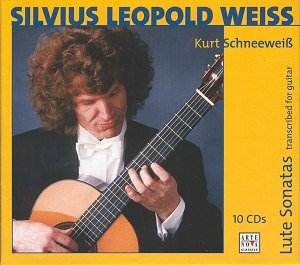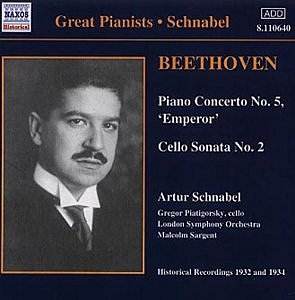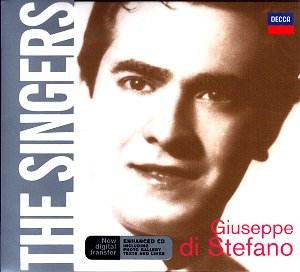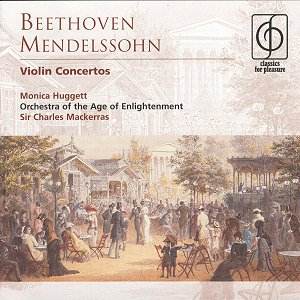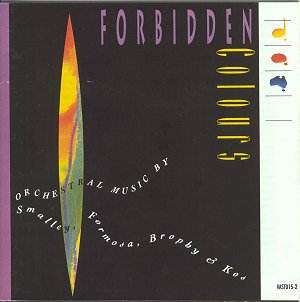 Composer: Various
Composer: Various
Works: Roger Smalley – Diptych (Homage to Brian Blanchflower), Riccardo Formosa – Dedica, Gerard Brophy – Forbidden Colours, Bozidar Kos – Violin Concerto
Performers: Melbourne Symphony Orchestra, Queensland Symphony Orchestra, Gunther Schuller, Patrick Thomas, Myer Fredman, John Hopkins, Dene Olding (violin), Jeffrey Crellin (oboe)
Recording: Live and studio recordings at Merlyn Theatre, Moorabbin Town Hall, and ABC Studios Brisbane
Label: VAST 015-2
The collection “Forbidden Colours” presents a compelling survey of contemporary Australian orchestral music through four works that highlight the evolution and diversification of the country’s classical landscape. Each composer—Roger Smalley, Riccardo Formosa, Gerard Brophy, and Bozidar Kos—offers a distinctive voice, drawing from both international influences and their Australian contexts. This compilation stands at a significant intersection of tradition and modernity, encapsulating a period where Australian composers sought to articulate their identities amidst broader global trends.
Roger Smalley’s “Diptych” serves as a robust entrée to this anthology. Composed in homage to painter Brian Blanchflower, the work is marked by its intricate orchestration and dramatic narrative arc. Smalley, who came to prominence within the British avant-garde milieu, employs a listener-friendly language that nonetheless retains a complexity that challenges the audience. The orchestration is masterful, with interweaving lines that evoke the vivid colors of Blanchflower’s canvases. The Melbourne Symphony Orchestra, under Gunther Schuller, delivers a performance that is both taut and expressive, capturing the work’s emotional depth while maintaining clarity amidst the dense textures.
In contrast, Riccardo Formosa’s “Dedica” presents a more fragmented expression, dominated by an elaborate oboe part that, while technically impressive, risks losing the listener in its excess of notes. Patrick Thomas’s interpretation of the oboe is commendable, showcasing his virtuosity; however, the piece feels overly ornate and lacking in thematic development. The studio recording, while clear and detailed, does not fully compensate for the work’s structural weaknesses, leaving it feeling somewhat insubstantial compared to Smalley’s offering.
Gerard Brophy’s “Forbidden Colours” emerges next, an evocative piece that juxtaposes rich orchestral colors with an ethereal oboe solo, beautifully executed by Jeffrey Crellin. The atmospheric opening suggests the vastness of the Australian landscape, replete with heat and light. Yet, at just over eleven minutes, the work seems to outstay its welcome, with a sense of repetitiveness that detracts from its initial allure. Myer Fredman’s conducting imbues the performance with a sense of urgency, but the material sometimes feels stretched, lacking the necessary development to warrant its length.
Bozidar Kos’s “Violin Concerto,” performed by Dene Olding, is a tour de force of virtuosity and tension. Kos, who brings a jazz background to his classical compositions, crafts a work that is both frenetic and introspective, culminating in a brief moment of repose before a reflective coda. The live recording captures the raw energy of the performance and highlights Olding’s technical prowess. The interplay between soloist and orchestra is deftly managed, creating a dynamic dialogue that is engaging throughout its twenty-minute duration.
The recording quality across this collection is notably vivid and immediate, a testament to the engineering prowess behind both live and studio sessions. Despite the challenges of live performance, the orchestras maintain precision and cohesion, a feat that enhances the listening experience. The sound engineering captures the nuance of orchestral textures, allowing for a rich auditory experience that complements the composers’ intentions.
“Forbidden Colours” provides a compelling glimpse into the diversity of contemporary Australian orchestral music. While some works may falter in their execution or thematic clarity, the strengths of Smalley’s and Kos’s contributions firmly establish the collection as a worthwhile exploration of this dynamic musical landscape. Each piece, in its unique way, reflects the broader currents of international influence while asserting a distinctly Australian voice. The disc ultimately serves as both a celebration and a challenge to the listener, inviting a deeper engagement with the evolving narrative of classical music in Australia.
